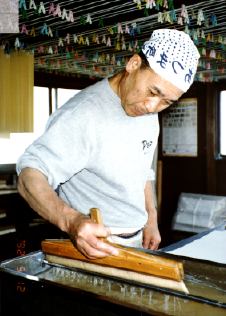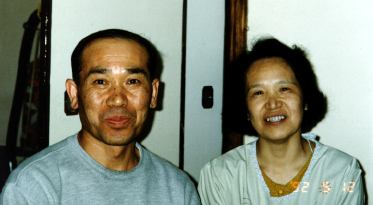Mr. Isami Misawa, paper sizer
Crocodile skin! I couldn't believe my ears. I knew
that shark skin is used in printmaking, but this was the first I'd
ever heard of crocodile skin (wani kawa) being utilized by
traditional printmakers. A hundred questions instantly bubbled up in
my mind. How on earth did the Edo craftsmen ever get hold of such a
product? What will my collectors think when they find out about this?
Why had I not heard of this before?
Misawa-san saw the obvious confusion on my face.
He patiently started to explain again what ingredients were in the
liquid sizing that he was brushing onto each sheet of paper. 'Myoban'
(alum) I understood. But 'wani kawa'...? And then the penny dropped.
Not wani kawa, crocodile skin, but wa nikawa, Japanese glue. What a
relief!
Everybody pretty much understands that my prints
are made on Japanese hand-made paper ('washi'), but what is not so
well-known is that it must be processed a bit before I can use it for
my work. After the Yamaguchi family has finished making the paper to
my specifications, they send it to Mr. Isami Misawa, who 'sizes' the
sheets one by one with a glue-like mixture, and gives them the
strength to stand up to the repeated rubbing with the printing baren.
One day this spring, I made the trip over to his workshop in
south-eastern Saitama to get better acquainted, and to see something
of how the work is done.
 Not all of the conversation went as badly as the
episode just recounted, and I spent a very enjoyable afternoon
watching the work, and listening to Misawa-san and his wife Hisako
tell me about what they do. Unlike almost all the craftsmen who have
a part in my project (including me), Misawa-san works standing up.
Some of his soft goat hair brushes are almost a full meter wide, and
there is no way to handle such tools sitting down. A trough full of
the warm size stands at the right end of his bench, and the stack of
soft 'raw' washi is placed in front. He works on a batch of about
five sheets at a time, covering first the front sides, then flipping
them over to do the back, thoroughly saturating each sheet. The
morning's stack of a few hundred sheets is then allowed to stand and
'even out', and in the afternoon the sheets are hung in pairs from
the million cords stretched across the ceiling. Hisako comes upstairs
to help him with this. Two hands are just not enough for this job, as
the soggy paper must be held very carefully in order not to allow
creases to form. They have been doing this together for a long time,
and their 'dance' is well rehearsed. His hand goes here, hers goes
there, they turn, lift to the ceiling, clip here, clip there, bend
back down to the stack .... (I hate to think what the afternoon's
work must be like if they quarrel at lunchtime!)
Not all of the conversation went as badly as the
episode just recounted, and I spent a very enjoyable afternoon
watching the work, and listening to Misawa-san and his wife Hisako
tell me about what they do. Unlike almost all the craftsmen who have
a part in my project (including me), Misawa-san works standing up.
Some of his soft goat hair brushes are almost a full meter wide, and
there is no way to handle such tools sitting down. A trough full of
the warm size stands at the right end of his bench, and the stack of
soft 'raw' washi is placed in front. He works on a batch of about
five sheets at a time, covering first the front sides, then flipping
them over to do the back, thoroughly saturating each sheet. The
morning's stack of a few hundred sheets is then allowed to stand and
'even out', and in the afternoon the sheets are hung in pairs from
the million cords stretched across the ceiling. Hisako comes upstairs
to help him with this. Two hands are just not enough for this job, as
the soggy paper must be held very carefully in order not to allow
creases to form. They have been doing this together for a long time,
and their 'dance' is well rehearsed. His hand goes here, hers goes
there, they turn, lift to the ceiling, clip here, clip there, bend
back down to the stack .... (I hate to think what the afternoon's
work must be like if they quarrel at lunchtime!)
The drying proceeds at a natural pace. He never
exposes the sheets to the sunshine, as papermakers sometimes do, as
this would result in a too rapid drying, and a resulting weakness in
the sized sheet. Misawa-san mentally gauges the humidity, and adjusts
the window openings to suit. The rainy season is of course a major
headache. The size can easily start to decay if left wet too long, as
nikawa is made from animal bones, (it is quite similar to the 'hide'
glue used by violin and guitar makers).
As I sat and watched him wield his large brush, I
was struck by how similar the rhythm of his work is to that of
Shimano-san the blockplaner, Matsuzaki-san the printer, Usui-san the
blacksmith, Yamaguchi-san the papermaker ... Although his arms are in
constant motion, the only part of his body that seems busy are his
eyes. They constantly rove over the sheets, looking for tell-tale
traces that would indicate where the size was too weak or too strong.
There is no stress, no apparent effort, no struggle. The sheets pass
under his hands one ... by one ... by one ... by one ... by one ...
It sounds immensely boring, but it is not. Those of you who have
never done this kind of work can never understand. It is not the
infernal, driving rhythm of the factory assembly line, but a rhythm
which comes from inside the craftsman himself. Misawa-san stands at
his desk, brush firmly grasped in hand ... dip - wipe - stroke -
flip, dip - wipe - stroke - flip ...
As we sit chatting later I learn that his work
even has an effect on his diet. If there were traces of oil on the
paper, the size would not penetrate properly, and the colours in the
finished print would be uneven. In order that the sheets of paper are
protected from even the tiniest traces of skin oils from their hands,
Misawa-san and his wife eat no tempura. A Japanese kitchen without
fried foods!

There are quite a number of different costs
involved for each of the finished prints that I send out: washi
500+yen, packaging 300yen, part-time helpers 500yen, postage 500+yen,
woodblocks 200+yen (per sheet), etc. Among all of these, by far and
away the smallest is the fee Misawa-san charges for his work: \60 per
sheet. He himself refers to his part as 'ichiban shita', the 'lowest'
part of the process. But I cannot carve without smooth woodblocks or
without a good blade. I cannot print without a good baren, good
washi, or without good sizing. Who among these craftsmen is to be
'ichiban shita'? I am sure you can guess my answer.
I was astonished to learn from Misawa-san that he
has never met Yamaguchi-san the papermaker. Decades of work together,
and yet all he knows of Yamaguchi-san is what he read in this
'Hyaku-nin Issho' newsletter a few months ago. As soon as I can
afford to do it, perhaps for the 'half way' exhibition in January of
1994, I want to bring all these craftsmen together (the men you have
read about in this newsletter, as well as the ones who have yet to
appear in these pages). I want to stand side by side with them in
front of my prints, and I want to show everybody in this country just
what a woodblock print really is. It is not Shunsho, or Utamaro, or
Hiroshige. It is a craftsman, his mind at rest but his full attention
focussed on the work before him, the sheets of paper (or twists of
bamboo, or slugs of steel) coming into his hands in a steady
confident rhythm, being worked on, and then being passed on to the
next man, and the next, and the next. And then finally passing to
you, the collector.
After I made my farewell, and walked up the road
toward the bus stop, I knew that Misawa-san was probably already back
upstairs at his bench, trying to make up for some of the working time
he had lost talking to me. But I also knew that no matter how late he
became, the rhythm would not vary. Each sheet would still get the
attention it needed. The sizing would be done properly. As you hold
your next new print to inspect it, spend a minute and think of
Misawa-san and his vat of 'crocodile skin' soup. The size he applied
to that sheet was actually only needed for the short time that the
paper was on my printing bench, and it will gradually disappear from
the paper over the course of the next few decades. But without it,
and without his skill, your print could not exist. Mr. and Mrs.
Misawa, thank you very much.